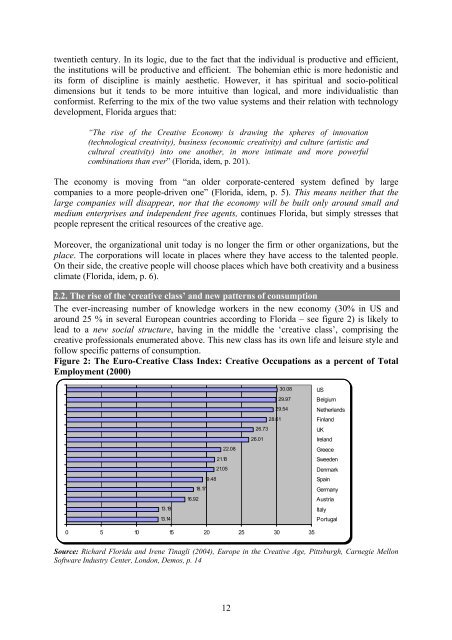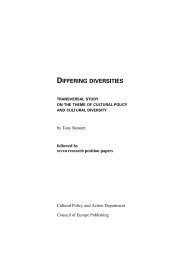twentieth century. In its logic, due to the fact that the individual is productive and efficient,the institutions will be productive and efficient. The bohemian ethic is more hedonistic andits <strong>for</strong>m <strong>of</strong> discipline is mainly aesthetic. However, it has spiritual and socio-politicaldimensions but it tends to be more intuitive than logical, and more individualistic thancon<strong>for</strong>mist. Referring to the mix <strong>of</strong> the two value systems and their relation with technologydevelopment, Florida argues that:“The rise <strong>of</strong> the <strong>Creative</strong> Economy is drawing the spheres <strong>of</strong> innovation(technological creativity), business (economic creativity) and culture (artistic andcultural creativity) into one another, in more intimate and more powerfulcombinations than ever” (Florida, idem, p. 201).The economy is moving from “an older corporate-centered system defined by largecompanies to a more people-driven one” (Florida, idem, p. 5). This means neither that thelarge companies will disappear, nor that the economy will be built only around small andmedium enterprises and independent free agents, continues Florida, but simply stresses thatpeople represent the critical resources <strong>of</strong> the creative age.Moreover, the organizational unit today is no longer the firm or other organizations, but theplace. The corporations will locate in places where they have access to the talented people.On their side, the creative people will choose places which have both creativity and a businessclimate (Florida, idem, p. 6).2.2. The rise <strong>of</strong> the ‘creative class’ and new patterns <strong>of</strong> consumptionThe ever-increasing number <strong>of</strong> knowledge workers in the new economy (30% in US andaround 25 % in several European countries according to Florida – see figure 2) is likely tolead to a new social structure, having in the middle the ‘creative class’, comprising thecreative pr<strong>of</strong>essionals enumerated above. This new class has its own life and leisure style andfollow specific patterns <strong>of</strong> consumption.Figure 2: The Euro-<strong>Creative</strong> Class Index: <strong>Creative</strong> Occupations as a percent <strong>of</strong> TotalEmployment (2000)13.1913.1422.0821.1821.0519.4818.1716.9230.0829.9729.5428.6126.7326.01USBelgiumNetherlandsFinlandUKIrelandGreeceSweedenDenmarkSpainGermanyAustriaItalyPortugal0 5 10 15 20 25 30 35Source: Richard Florida and Irene Tinagli (2004), Europe in the <strong>Creative</strong> Age, Pittsburgh, Carnegie MellonS<strong>of</strong>tware Industry Center, London, Demos, p. 1412
Using the criteria ‘age’ and ‘income’, Florida tries a classification <strong>of</strong> leisure activitiespreferred by American people. Even if data are not definitive, they show several specifictrends which might be found in Europe as well in certain measures:• “High-income people between eighteen and thirty-four years <strong>of</strong> age (with incomes <strong>of</strong> more$75,000) are more than two times as likely as the average person to scuba dive, snow ski,travel, plays tennis, fly frequently or jog, whereas low-income people in this age group (thosewith incomes <strong>of</strong> $30,000 or less) are more likely to play home video games, horseback ride,fiddle with electronics, camp, ride a motorcycle or do automotive work.• The same basic pattern holds <strong>for</strong> people in the thirty-five-to <strong>for</strong>ty-four-year-old age group.High-income people in this age group are more than two times more likely than average totravel, ski or scuba dive, and more than one and a half times more likely to play tennis, golf,jog and enjoy wines. Lower-income people in this age group are more likely to horsebackride, play video games, collect stamps, ride motorcycles, camp and do automotive work.• Affluent middle-aged Americans between the ages <strong>of</strong> <strong>for</strong>ty-five and sixty-four are significantlymore likely than average to own a vacation home, travel, enjoy wines, golf, sail and attendsarts and cultural events, whereas lower-income people in this age group are more likely tospend time with their grandchildren, enter sweepstakes, sew and do needlework, collectstamps, coins and other things, read the Bible and engage in crafts.” (Florida, 2002, p, 173)Corroborating with the fact that the wages and salaries <strong>of</strong> the creative class are bigger than <strong>of</strong>all the other classes - their members earn about twice in average that the members <strong>of</strong> the othertwo classes (table 3) - and interviewing members <strong>of</strong> the creative class, Florida reached at theconclusion that the members <strong>of</strong> creative class prefer active recreation <strong>for</strong> their spare time.Table 3: Wages and salaries <strong>for</strong> the classes, 1999 (American population)CategoryTotalWorkersAverageHourly WageAverageAnnual Salary<strong>Creative</strong> Class 38,278,110 $23.44 $48,752Super-<strong>Creative</strong> Core 14,932,420 20.54 42,719Working Class 33,238,810 13.36 27,799Service Class 55,293,720 10.61 22,059Agriculture 463,360 8.65 18,000Entire US 127,274,000 15.18 31,571Source: Richard Florida, (2004), The rise <strong>of</strong> the creative class, New York, Basic Books, p. 77With work which is mainly intellectual and sedentary, they try to recharge their batteriesthrough physical activity. But they usually do not show significant interest in spectator sports,wishing to participate directly. They seek <strong>for</strong> a lot <strong>of</strong> experience per unit <strong>of</strong> time and theywant adventure argues Florida further. While in the competitive sports (such as baseball) youare against the opponent, the adventure sports test you against your own limits or you againstthe task or nature. The spectator sports are attended mainly by the Working Class members.This fact is explained by Florida by their need to identify themselves with winners – due tothe fact that in their standard life they do not win at all – and as well as a means <strong>of</strong> imitatingthe superior class, having an in<strong>for</strong>med opinion on issues as why the x or y team is going towin.The creative class members prefer the street-level culture to large venues, mainly becausethey feel this way entering a cultural community, not just attending an event. With Florida’swords:13














